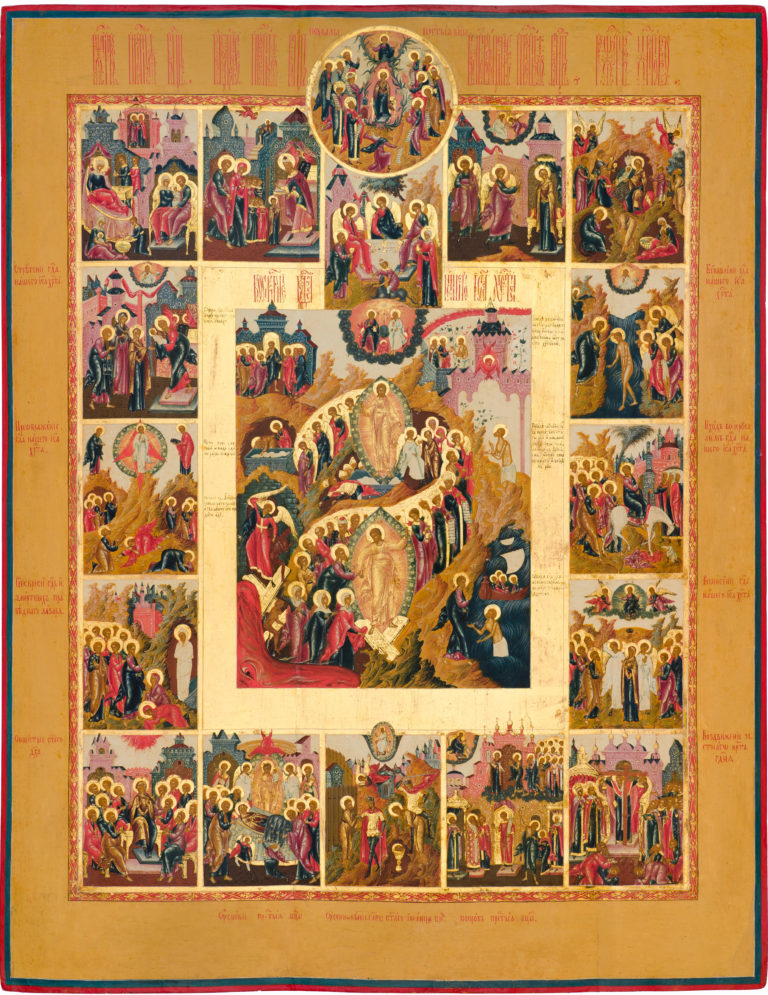The Resurrection—the Descent into Hell, with the Praise to the Mother of God and Church Feasts in 16 Border Scenes
Icon: End of the 18th century. Palekh
Size: 71 х 55 х 2,8 cm
Wood (three panels), two incut support boards, absence of the incut centerpiece, the underlying layer of canvas is probable, gesso, tempera.
The author’s paintwork is very well preserved.
Contact us

The Resurrection—the Descent into Hell, with the Praise to the Mother of God and Church Feasts in 16 Border Scenes
Diagram of the border scenes:
- The Nativity of the Mother of God;
- The Entrance of the Mother of God into the Temple;
- The Old Testament Trinity;
- The Annunciation;
- The Nativity of Christ;
- Candlemas (The Meeting of Christ in the Temple);
- The Theophany (The Baptism of Christ);
- The Transfiguration;
- The Entrance into Jerusalem;
- The Raising of Lazarus;
- The Ascension;
- Pentecost;
- The Dormition of the Mother of God;
- The Beheading of John the Baptist;
- The Pokrov (Feast of the Protective Veil of the Mother of God);
- The Elevation of the Holy Cross;
- The Praise to the Mother of God.
Eastern Orthodox icons depicting the major Feast cycle of the Liturgical year were known among artists of the Russian Empire as polnitsy (basically “full” or “full-cycle” religious icons). Such complex compositions allowed artists to bring together different New Testament scenes on a single panel, which made these hand-painted icons incredibly popular among all Russian social classes. Palekh artists, whose religious icon paintings are now recognizable due to the intricacy of the “miniature” painting-style, were especially fond of this iconographic scheme.
Following the dominant tradition, the centerpiece of this antique Russian icon bears the detailed iconographic depiction of the Resurrection. Scenes of the “Rising from the Tomb” and “The Harrowing of Hades” are depicted along a single vertical line and are compositionally bound together by the diagonal procession of the Pious marching into Heaven. This composition is surrounded by scenes that came before or followed the Resurrection. The top left corner bears the image of the Incredulity of Thomas and the Apostle Peter at the Empty Tomb; in the lower right corner – the Revelation of Christ to the Apostles on the Sea of Galilee.
The Resurrection centerpiece is surrounded by sixteen border scenes, bearing quite traditional depictions of major Church Feasts. It begins with the Nativity of the Mother of God, which is placed in the top left corner of the religious icon marking the beginning of the yearly liturgical cycle of Feasts, and ends with the Elevation of the Holy Cross, which is placed in the lower right corner of this antique icon. The introduction of the Old Testament Trinity into the upper row of the composition – which breaks the calendar sequence of the liturgical year – is typical for the iconographic scheme developed in Palekh. The theological significance of the Trinity’s introduction is obvious: it is seen as the symbol of God’s plan of His self-sacrifice and the salvation of mankind, the reunification of the three hypostases of the Holy Trinity following the Resurrection of Christ, the coming of Man into the Kingdom of Heaven.
The scenes of the Raising of Lazarus and the Beheading of John the Baptist are also highly symbolic. John the Baptist was the first person to announce the sacred meaning of Christ’s incarnation and the mystery of the world’s salvation through the Messiah, while the Raising of Lazarus can be seen as both the sign of Christ’s Resurrection and the promise of Salvation for Mankind.
The given hand-painted icon is one of the first-class Eastern Orthodox icons painted by Palekh iconographers in the end of the 18th century – a time when artists of this settlement mainly worked on highly-expensive commissioned works of art. The masterpiece of Palekh’s artists reflects their orientation on Stroganov heritage. This is especially evident in the elongated body-proportions with their small, round heads and elegant limbs; the yearning for iconographic narratives, which originated in the Russian tradition in the first half of the 17th century and was brought to its finest stage with the refined miniature painting and complex, detailed imagery of Palekh. The ease and craftsmanship of the artist, the masterful execution of the architecture with its vivid ornamentation, the multicolored, almost ethereal mountains are brilliantly combined with the contemplative softness of the religious icon painting style, which is an indicative trait of late 18th century Palekh iconography. This assessment is supported by a large number of analogies found in various public and private collections of antique Russian icons. The exclusive, precious beauty of the artwork is enforced by a rich, gilded cinnabar frame – another decorative motif beloved by Palekh’s artists.